Filtering well: purpose and device
In a private house rather remote from the city there is usually no central sewage system. But, the sewage, which is a product of human life, there is and they need to go somewhere.
Often this is an ordinary sewage pit, which is fundamentally wrong and leads to contamination of the soil and groundwater. The best solution is the arrangement of a septic tank with a filter well, which we will consider in this article.
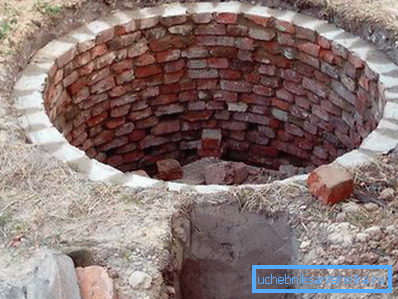
General provisions
First of all, let's get acquainted with the functionality of such a device and its alternatives (find out here how to make a water filter for the well yourself).
Functions
The filter well has the following purposes:
- Filtration of wastewater that leaves the septic tank after the preliminary stages of purification. The process is performed by a bottom filter located at the base of the structure.
Advice: if we are talking about a cottage where you do not live permanently, and its volume of wastewater does not exceed one cubic meter per day, then you can do without a septic tank with a single well cleaning. This will greatly save the budget.

- Creating a garden irrigation system. Ultimately, with the observance of technology, the liquid has a sufficient degree of purification for using it as a watering of vegetable crops.
- Localization of pollution. The drains will not spontaneously be poured over the section, but will be in a place strictly designated for them.
Alternatives
It should be noted that this is not the only way to purify water after a septic tank.
Also apply:
- Absorbing trench. Low price, but poor cleaning and space requirements.
- Sand and gravel filters. Weak localization, there is the possibility of dirty liquid immediately into the ground.
- Underground filtration field. After several years of using this option, it is necessary to transfer the entire sewer system to another place due to the unsuitability of the soil for further cleaning.

The use of a well, although it requires some moderate costs and labor for its creation, is at the same time the most rational structure for the purification of waste liquid.
Installation
It is not at all difficult to build a filtering well with your own hands; it does not require any construction or engineering skills. But the general ideas and some nuances need to be known.
Location selection
There are several conditions that must be observed during the construction of the cleaning wells to guarantee their efficient and harmless work:
- The depth of groundwater. Between the bottom of the structure and the water should be a distance of not less than one meter.
- Presence at the well site on the water. The maximum distance from each other of these objects is required to avoid pollution of the aquifer.
- Type of soil. Perfectly suitable: sandstone, sandy loam and peat. Clay, for example, does not fit in its structure as a filter.
You should know: the size of the area of the well directly affect its life. As the large filter becomes dirty more slowly than the small one.
Arrangement
The following instructions will help you to do everything right:
- We dig out a pit, the main condition for which is its deepening below the level of soil freezing and keeping at least 100 cm from the groundwater. We choose dimensions based on the amount of daily wastewater flow.
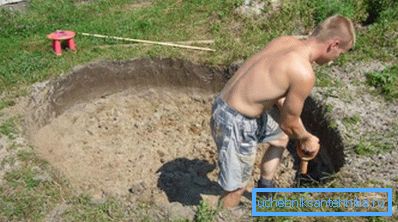
- Create a bottom filter. This is the most important element that produces the filtering itself.
To do this, we fall asleep meter layer of granular load, in the form of which will fit:
- gravel;
- rubble;
- clay slag;

- Punch a hole to the septic tank at a level not lower than fifteen centimeters from the material of the bottom filter.
- We connect designs sewer pipe.
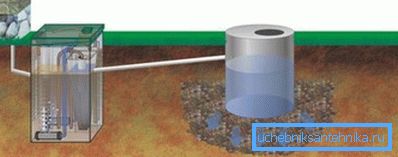
Tip: a pipe board should be installed under the pipe. This will promote uniform distribution of fluid throughout the bottom and eliminate leaching.
- We build walls. However, their surface should have holes with a diameter of 5 cm and in 10 cm increments in a checkerboard pattern.
Materials suitable for this task:
- Brick or natural stone. On the one hand, it is easy to create the necessary holes, on the other hand, brickwork is a very laborious task.
Tip: when using bricks, choose only well-baked products. Silicate samples, being constantly in the water, will quickly become useless.

- Stainless steel barrel. Strong, easy to install, but expensive and limited in area - it is not easy to find a sample with a sufficiently large diameter.
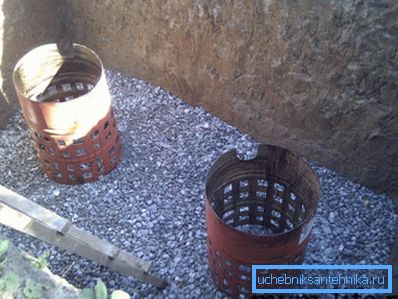
- Concrete rings. Practical, reliable, affordable option. Such filter wells are most common.
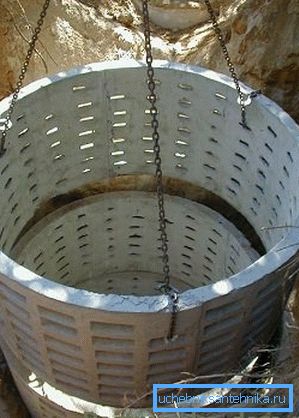
- In the ceiling we install an exhaust pipe with a diameter of 10 cm and a height of at least 30 cm above the ground. We equip its outlet opening with a special umbrella to protect it from precipitation.
- For access inside we mount the hatch with two covers: carrier and warming. The recommended diameter for them is 70 cm. Between them we lay a warming material, which can be mineral wool, extruded polystyrene foam or felt.
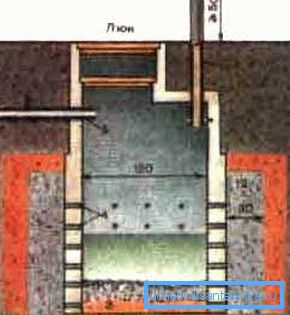
- The gaps between the walls of the structure and the ground, which should be about half a meter, we fall asleep with the same material that we used to create the bottom filter.
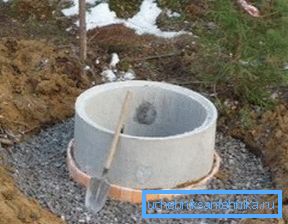
Conclusion
The problem of sewage waste in places where there is no central sewage should be approached with great responsibility. Otherwise, the site can be contaminated to the level when it becomes unsuitable for growing any plants.
One of the best methods of wastewater treatment at a country site is the arrangement of a filtering well in tandem with a septic tank. And with small volumes of waste, you can even limit yourself to a well. The creation of which is quite do-it-yourself.
The main points of installation: the optimal choice of location, laying the bottom filter and installing walls.

The video in this article will acquaint you with additional materials on the subject in question. The filter well can perfectly complement your own sewer system on the site.